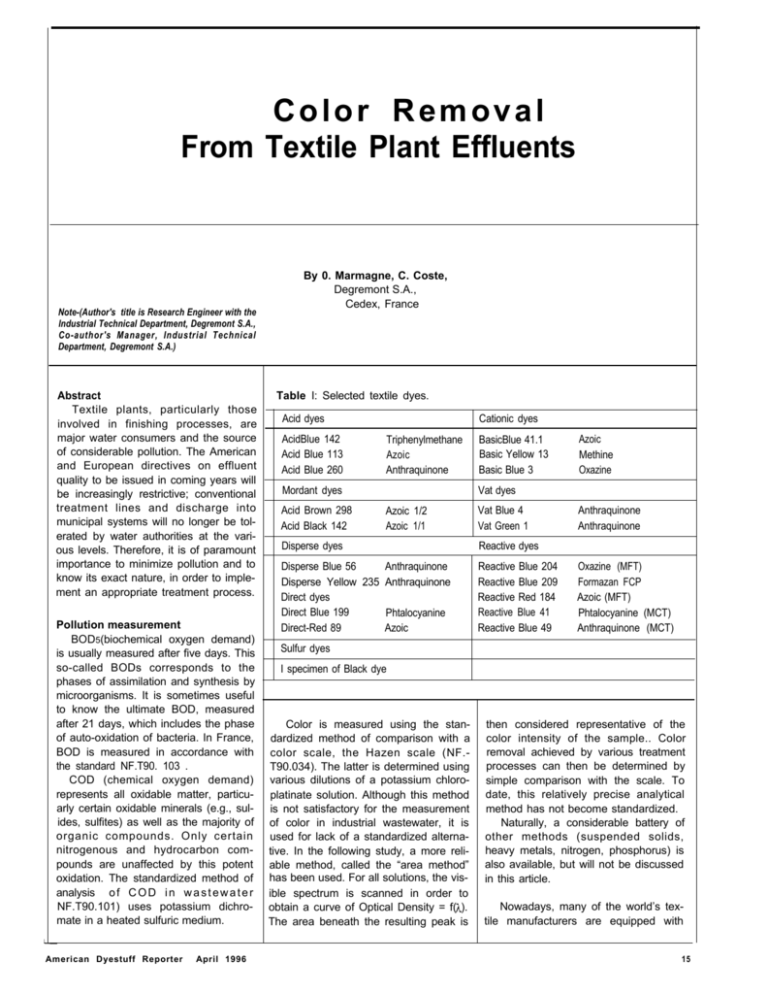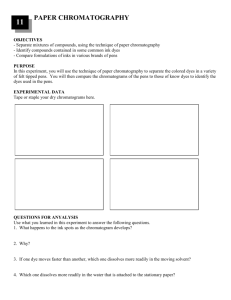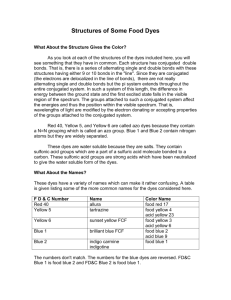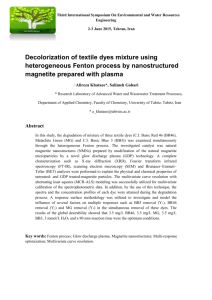Color Removal From Textile Plant Effluents
advertisement

Color Removal From Textile Plant Effluents Note-(Author's title is Research Engineer with the lndustrial Technical Department, Degremont S.A., Co-author's Manager, Industrial Technical Department, Degremont S.A.) Abstract Textile plants, particularly those involved in finishing processes, are major water consumers and the source of considerable pollution. The American and European directives on effluent quality to be issued in coming years will be increasingly restrictive; conventional treatment lines and discharge into municipal systems will no longer be tolerated by water authorities at the various levels. Therefore, it is of paramount importance to minimize pollution and to know its exact nature, in order to implement an appropriate treatment process. Pollution measurement BOD5(biochemical oxygen demand) is usually measured after five days. This so-called BODs corresponds to the phases of assimilation and synthesis by microorganisms. It is sometimes useful to know the ultimate BOD, measured after 21 days, which includes the phase of auto-oxidation of bacteria. In France, BOD is measured in accordance with the standard NF.T90. 103 . COD (chemical oxygen demand) represents all oxidable matter, particuarly certain oxidable minerals (e.g., sulides, sulfites) as well as the majority of organic compounds. Only certain nitrogenous and hydrocarbon compounds are unaffected by this potent oxidation. The standardized method of analysis o f C O D i n w a s t e w a t e r NF.T90.101) uses potassium dichromate in a heated sulfuric medium. American Dyestuff Reporter April 1996 By 0. Marmagne, C. Coste, Degremont S.A., Cedex, France Table I: Selected textile dyes. Acid dyes AcidBlue 142 Acid Blue 113 Acid Blue 260 Cationic dyes Triphenylmethane Azoic Anthraquinone Mordant dyes Acid Brown 298 Acid Black 142 BasicBlue 41.1 Basic Yellow 13 Basic Blue 3 Azoic Methine Oxazine Vat dyes Azoic 1/2 Azoic 1/1 Vat Blue 4 Vat Green 1 Disperse dyes Reactive dyes Disperse Blue 56 Anthraquinone Disperse Yellow 235 Anthraquinone Direct dyes Direct Blue 199 Phtalocyanine Direct-Red 89 Azoic Reactive Blue 204 Reactive Blue 209 Reactive Red 184 Reactive Blue 41 Reactive Blue 49 Anthraquinone Anthraquinone Oxazine (MFT) Formazan FCP Azoic (MFT) Phtalocyanine (MCT) Anthraquinone (MCT) Sulfur dyes I specimen of Black dye Color is measured using the standardized method of comparison with a color scale, the Hazen scale (NF.T90.034). The latter is determined using various dilutions of a potassium chloroplatinate solution. Although this method is not satisfactory for the measurement of color in industrial wastewater, it is used for lack of a standardized alternative. In the following study, a more reliable method, called the “area method” has been used. For all solutions, the visible spectrum is scanned in order to obtain a curve of Optical Density = f( ). The area beneath the resulting peak is then considered representative of the color intensity of the sample.. Color removal achieved by various treatment processes can then be determined by simple comparison with the scale. To date, this relatively precise analytical method has not become standardized. Naturally, a considerable battery of other methods (suspended solids, heavy metals, nitrogen, phosphorus) is also available, but will not be discussed in this article. Nowadays, many of the world’s textile manufacturers are equipped with 15 reported as grams of 02 per gram of dye. Note that the COD corresponds to a commercial dyestuff and includes any and all additives contained in the formula. The results are shown in Table Il. The following rule of thumb may be derived: Direct = Sulfur < Mordant = Reactive < Cationic < Dispersed < Acid < Vat l Biological processes were not implemented due to the long period needed for biological organisms to become acclimated and to the low biodegradability of dyes. l Coagulation-flocculation: the aim is to know whether dyes can be easily coagulated and flocculated. No effort is made to optimize coagulant dosages. The coagulation is carried out in bench flocculators (six l-liter units). Following a mixing time of 10 minutes, the floc is allowed to settle for 15 minutes. The accepted system of floc notation is as follows: 0: no floc 2: slightly visible floc, opalescent water 4: small floc 6: medium-sized floc with clear interstitial water 8: well-formed floc with clear, shining interstitial water 10: very well-formed floc with clear, shining interstitial water The results obtained are compiled in Table III. Cationic dyes do not coagulate at all; making their removal by physical-chemical (coagulation-flocculation) process impossible. Acid, direct, vat, mordant and reactive dyes usually coagulate, but the resulting floc is of poor quality and does not settle well even after introduction of a flocculant. Thus, a coagulation-flocculation treatment will yield mediocre results. It is not inconceivable that this property could be an advantage in membrane processes. Sulfur and dispersed dyes coagulate well and settle easily, thanks to the fornation of good-quality floc. Accordingly, color removal is practically complete. Thus, the efficiency of the coagulationflocculation process is excellent for this type of dye. From the standpoint of water recycling, membrane techniques hold great promise. The various dyes are studied to see if removal is possible by microfiltraion, ultrafiltration or nanofiltration mod- 18 Table IV: Efficiency of membrane treatment. Table V: Efficiency of activated carbon treatment. Color removal COD removal (%) (%) 71.4 93.7 Structure Dye AcidBlue 142 Triphenylmethane Acid Blue 113 Azoic 70.9 95.6 Acid Blue 260 Anthraquinone 58.8 86.8 Basic Blue 41.1 Azoic 84.7 100.0 BasicYellow 13 Methine 81.5 99.7 67.8 98.5 0.0 10.1 Basic Blue 3 Oxazine Vat Blue 4 Anthraquinone Acid Brown 298 Azoic 1/2 91.5 97.1 Acid Black 142 Azoic 1/1 82.1 98.1 Reactive Blue 204 70.6 69.0 Reactive Blue 209 Formazan (FCP) 89.8 78.5 Reactive Red 184 Azoic (MFT) 69.4 77.6 74.6 57.4 19.2 94.6 Oxazine (MFT) Reactive Blue 41 Phtalocyanine (MCT) Reactive Blue 49 Anthraquinone (MCT) Sulfur 45.5 I I 40.9 American Dyestuff Reporter April 1996 Table VI: Efficiency of ozonation. Color rem (%) Structure Dye Acid Blue 142 Triphenylmethane 11.6 91.5 Acid Blue 113 Azoic 87.8 98.7 Acid Blue 260 Anthraquinone 82.3 99.3 Basic Blue 41.1 Azoic 97.6 100.0 Basic Yellow 13 Methine 95.2 100.0 Basic Blue 3 Oxazine Vat Blue 4 Anthraquinone 83.9 39.6 83. 100.0 40.2 84.6 2.9 36.7 0.0 19.8 Vat Green I Anthraquinone 43.5 103.5 13.2 35.5 11.1 53.1 Direct Blue 199 Phtalocyanique 44.2 73.4 46.9 84.4 62.8 98.8 Direct Red 89 Azoic 44.9 40.0 94.4 79.9 100.0 100.0 Disperse Blue 56 Anthraquinone 27.2 88.3 4.0 34.1 1.4 99.6 Disperse Yellow 235 Azoic 36.8 60.8 18.5 36.1 3.2 11.5 Acid Brown 298 Azoic l/2 57.2 110.8 58.6 72.9 86.1 98.7 Acid Black 142 Azoic l/l 31.4 103.3 21.8 72.4 66.7 99.3 Reactive Blue 204 Oxazine (MFT) 49.2 83.1 13.3 67.3 83.2 99.7 Reactive Blue 209 Formazan (FCP) 43.1 80.3 19.4 45.8 90.1 99.0 Reactive Red 184 Azoic (MFT) 40.7 82.2 24.3 85.2 83.2 99.7 Reactive Blue 41 Phtalocyanine (MCT) 43.3 88.7 25.8 44.8 69.0 99.5 Reactive Blue 49 Anthraquinone (MCT) 48.0 81.4 50.6 85.9 95.9 99.4 50.9 92.7 46.8 83.0 62.0 95.5 Sulfur ing effect and show preference for the double bonds of the dye molecules. Oxidation of indigo by ozone is one example (Figure 3). The column has a capacity of 8 liters of colored effluent. The typical flow diagram for the ozonation pilot unit is shown in Figure 4. Experimental results are compiled in Table VI. Ozonized oxygen is injected into a PVC column through a porous diffuser. Color removal Color removal is generally effective and fairly rapid using ozone. Again, it is the class of dye that is most significant in determining the behavior of the dyes. To a lesser extent, the chemical structure, if highly compact (phtalocyanine, triphenylmethane, etc.) can have a negative impact on the rate of reaction. Reasonable ozone dosages (50 mg/L) usually allow very efficient color removal for acid, mordant, cationic, direct, reactive, and sulfur dyes. Removal of a significant portion of the COD can also be anticipated, even if it is sometimes necessary to push the ozone dosage somewhat higher. Dispersed and vat dyes are generally difficult to remove, even at high ozone dosages. Ozone is not an efficient treatment solution for these dyes. Future prospects As stated, biological and coagulationflocculation treatments have proven insufficient to remove color from a textile plant effluent. They produce an effluent characterized by relatively few COD, low biodegradabiiity and high color. The use of coagulants specific to color removal applications may be considered. But although the removal efficiencies will improve slightly, the result will often remain insufficient. The same observation can be made regarding powdered activated carbon, which can be used as a complement to a biological or physical-chemical treatment. This will lead to somewhat enhanced perfornance. This option is viable only for solutions with low residual color. The use of granular activated carbon (GAC) would be prohibitively costly. The only alternatives remaining are ozone and membrane processes. With membranes, the significant danger of clogging would undoubtedly call for filtering a coagulated effluent (with ferric chloride as the coagulant, for example), unless care is taken to select the type Of membrane best suited to the effluent. This would yield a non-colored permeate that could either be returned to the process or discharged to the sewer. However, the resulting concentrate wouId need to be treated and placed in landfill. Ozone emerges as the most univeral solution offering satisfactory efficiency. It produces an effluent with no color, low COD, and suitable for discharge into the environment or return to the process. American Dyestuff Reporter April 1996





